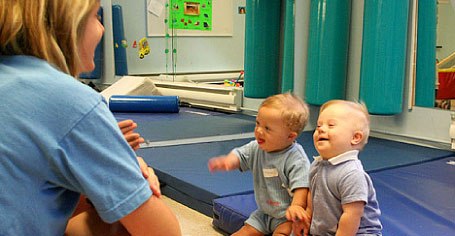
Prevent the behaviour
Many problem behaviours can be prevented by making the behaviour irrelevant or not important. You can do this by changing the antecedent conditions – the things that happen right before the behaviour. Here are some suggestions:
- Plan smooth transitions – When changing from one activity to another give your child plenty of warning. Try using visuals, such as pictures to help your child understand what activity or event is coming next.
- Reduce waiting times – Young children can get restless when having to wait for a long time. When it is unavoidable, like waiting in line at the supermarket, bring a small toy for your child to play with, a book to read, or play a game like “Peek-a-Boo”.
- Set simple rules – Setting rules ahead of time and reviewing them regularly will help your child understand what to do and what to expect. Be clear and consistent about what the rules are and the reasons for them.
- Give clear instructions – Get down to your child’s level and speak in clear, simple words that let your child know exactly what you want him to do. Using gestures and visuals can also help your child understand.
- Reduce distractions – Many things, such as sounds, too many toys, television, or people can distract your child and lead to lack of focus. Take note of the things that are happening in the environment when problem behaviour occurs. Sometimes taking away or reducing a distraction can lead to greater success.
- Provide choices – Making a choice can help build your child’s self-esteem and reduce the likelihood of a power struggle. You will need to decide on and prepare the choices in advance. It is best to start with only two choices and gradually add more. A visual “choice board” can help you to organize this by creating pictures that represent all the “choices”.
Teach new skills or alternative behaviour
Many problem behaviours can also be made inefficient, or have no value for your child. You can do this by teaching an alternative to the behaviour (a more appropriate behaviour), such as teaching your child to ask for help instead of climbing furniture to reach a toy.
- Begin by gathering information
- Try to find the reason for your child’s behaviour – Why does he do that? You can use the ABC Assessment Chart to help you gather information about the problem behaviour including what happens before the behaviour, what the behaviour is, and what happens afterwards. Check out the For More Information box at the end of this document for details.
- Consider what you want your child to be doing instead of the problem behaviour. What will give him the same pay-off or result, but is more acceptable? What skills might help him to cope better with difficult situations?
- Select the right alternative behaviour
- The key is to introduce a new skill, or alternative behaviour that:
- serves the same function or reason as the problem behaviour
- is simple or easy for your child to do
- Best teaching strategies should be used
- Break new skills down into small steps, and then teach each step. This is also known as Task Analysis. Check out the For More Information box at the end of this document for further details.
- Model the desired or appropriate behaviour for your child.
- Use visual supports, such as pictures, to help teach the steps.
- Reinforce your child for using the new skill or appropriate behaviour. Give him lots of verbal praise, or a special toy to play with.
Change the Results
Many problem behaviours can be made ineffective, or not successful for your child by changing the consequences. The consequences are things that happen after the behaviour.
- Catch your child doing something right
- Find genuine occasions to reinforce your child for his positive behaviour (e.g., “Wow, Jamal! Good tidying up your toys!”).
- Find reinforcements (e.g., verbal praise, preferred objects or activities) that will really motivate your child to use positive or alternative behaviours.
- Respond to problem behaviour by:
- Ignoring the behaviour (unless it could harm people or property).
- Re-direct your child to another activity.
- Use “no” carefully. Say “no” only when it is critical that your child stop the behaviour immediately.
TIPS FOR PARENTS TO REMEMBER
Behaviour change takes time and effort
- It takes time to make changes so don’t expect immediate success.
- Often, behaviour gets worse before it gets better. This can be the most difficult stage of changing your child’s behaviour.
- Be consistent and stick to your plan.
- Make sure that all the people who interact with your child use the same plan and strategies.
Reward the right behaviour(s)
- Know what appropriate behaviour you want to reward.
- Don’t make promises or threats that cannot be followed through.
- Make sure the consequence is clear to your child.
Pick your battles
- Don’t overwhelm your child by creating too much change at one time.
- Select the most important behaviour and work on that first.
- Ask for support if you need it.
